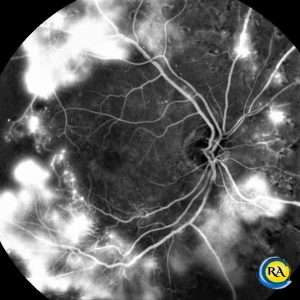Pan retinal laser photocoagulation, or PRP is a minimally invasive procedure performed in the office. Your physician may choose this option to treat leaking blood vessels in the retina due to proliferative diabetic retinopathy. Proliferative diabetic retinopathy effects a wider area of the retina, therefore when compared to focal laser treatment for other retinal conditions, more laser burns may be needed to stabilize the central vision and prevent further vision loss.
PRP targets abnormal blood vessels due to proliferative diabetic retinopathy, or PDR. If left untreated, PDR can severely decrease vision, both centrally, and peripherally. The purpose of the laser is to slow or stop the abnormal blood vessel growth in the retina. Multiple laser burns are made throughout the periphery, and/or the area surrounding the central vision, or macula. If these abnormal vessels are not treated, conditions such as vitreous hemorrhage, macular edema, and tractional retinal detachments may occur, causing the need for invasive surgical procedures, as well as possible severe vision loss. Pan retinal photocoagulation is a preventative treatment option your physician will discuss with you.
The PRP procedure is performed in the office. The eye of concern will be anesthetized, or numbed with topical eye drops prior to the procedure. The eye will also be dilated in order to allow the physician to view the retina as clearly as possible. A contact lens will be placed on the eye during the time of the procedure to magnify the vessels of concern. You will experience multiple bright light flashes, as the physician targets the leaking blood vessels with the laser. A technician will be by your side to provide support and assistance. For most patients, the treatment takes minutes to complete as the physician secures the problematic blood vessels. In most cases, multiple laser sessions may be required and your physician will review all options with you.
After the laser treatment is complete, your vision may appear darker than normal, blurry, and/or you may see spots. This is normal and your vision should be restored within the next few days. The PRP laser treatment may cause your eye to feel some discomfort over a few days. Again, the purpose of the PRP laser is to ensure central vision is sustained. The peripheral blood vessel growth in proliferative diabetic retinopathy will not go away on its own. Without treatment, the expectation of loss of vision is imminent.
Patients should have a family member or friend to drive them home as their pupils will be dilated for a few hours and they may be light-sensitive.
Retinal laser photocoagulation has a low risk of infection; however, patients may experience areas of decreased vision and reduced night vision. These effects may be temporary, but may last longer. After PRP treatment, peripheral vision may be decreased momentarily or indefinitely. However, the goal of the PRP laser is to ensure central vision will be secured.
The risk of severe, permanent loss of vision without treatment is greater than the mild side effects in vision post (after) laser treatment. Your physician will discuss the process with you and answer any of your questions.


